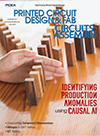Features Articles
 A plan for coordinating 2-D and 3-D x-ray and microsectioning strategies.
A plan for coordinating 2-D and 3-D x-ray and microsectioning strategies.
Last month I discussed use of “full CT” (FCT), or 3-D x-ray, for analyzing electronic components and boards. This provides a 3-D model of the sample from which “virtual x-ray microsections” can be taken at any plane within the sample for analysis. While this can give excellent information, it does take time for the quantity of 2-D x-ray images to be acquired from 360° around the sample, from which the 3-D model is produced. Furthermore, as electronic features are small, it usually requires a set of high magnification 2-D images to provide the analytical detail within the 3-D model. As I have mentioned, the geometric magnification provided by an x-ray system depends on being able to place the object/field of view (FOV) close to the x-ray tube. As the sample is rotated within the tube-detector axis for FCT, then the larger the sample, the further away the sample must be placed to prevent a collision with the tube during rotation. Although it is possible to create an FCT model by only taking images from 180° around and using careful sample placement to allow an FOV to be placed closer to the tube, detailed information is unavailable for the model because only half the potential data are taken. Looking at an individual component under full CT does permit its placement close to the x-ray tube for high-magnification images. Once that component is on a board, however, the available high magnification for full CT is likely to be lost. At this point, cutting the sample to reduce its size becomes the only realistic option to getting the required detail from the FCT model.

Your customer wants to grow. Are you ready for the transition?
One of the difficult challenges small electronics manufacturing services (EMS) companies face is the transition from a transaction-based job shop to a relationship-based, full-service EMS provider. There are a number of issues to consider prior to taking that journey.
Is it necessary? Bigger isn’t always better. The US is full of small job shops that are profitable and right-sized for their ownership and long-term strategy. At the same time, there are also companies that successfully redefine that model within their region and grow at a pace they are comfortable with. And, a restructuring in trade agreements and tax structure may drive greater opportunities for growth over the next few years as OEMs update their business models to take advantage of this change in the playing field.
 Mixed-technology designs are prime for waste elimination. Here’s how.
Mixed-technology designs are prime for waste elimination. Here’s how.
Taiichi Ohno developed the concept of the seven wastes (muda) in manufacturing as part of the Toyota Production System (TPS), the foundation for Lean manufacturing philosophy. They are:
- Waste of overproducing (no immediate need for product being produced).
- Waste of waiting (idle time between operations).
- Waste of transport (product moving more than necessary).
- Waste of processing (doing more than what has been agreed upon).
- Waste of inventory (excess above what was required).
- Waste of motion (any motion not necessary outside of production).
- Waste of defects (producing defects requiring rework).
 Wisdom comes with a charge. Usually by the hour.
Wisdom comes with a charge. Usually by the hour.
I like old things. Old shirts. Or old soft sweaters. Old test engineers recommend themselves. Old explanations. You know what to expect. Like a long-term, happy marriage. There’s a comfort level. Fewer mistakes, more detail. Less bewilderment. General competence. Analog testing. The ability to answer the question, “Why?” in waveform. Experience and familiarity sometimes matter. Some dare call it wisdom.
Why do we still worship youth? Haven’t we learned?
Old cars provide a certain comfort, too. As of this writing, my current model has accompanied me faithfully for 14 years and 417,000 miles with no engine rebuilds. Sure, the leather in the driver’s seat is ripped, but it’s still comfortable, and the ride remains blissfully smooth. So, I keep it. For now. Cognizant that the risk-reward ratio is tipping left toward risk with each succeeding day. Am I pushing my luck? Probably. But it still works. I know what to expect. So much else in life isn’t that way.
Press Releases
- NEPCON ASIA 2025: Innovating Smart Manufacturing Ecosystems and Bridging Global Opportunities
- Viasion Technology Expands Global Reach as a Trusted PCB Manufacturer and EMS Provider in China
- Viasion Technology Expands Global Reach as a Trusted PCB Manufacturer and EMS Provider in China
- Nordson Test & Inspection Expands Partnership with Distributor smartTec Nordic A/S




